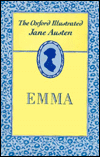The Oxford Illustrated Jane Austen: Volume IV: Emma
This is one of a complete set of Jane Austen's novels collating the editions published during the author's lifetime and previously unpublished manuscripts. The books are illustrated with 19th-century plates and incorporate revisions by experts in the light of subsequent research.
1100006296
The Oxford Illustrated Jane Austen: Volume IV: Emma
This is one of a complete set of Jane Austen's novels collating the editions published during the author's lifetime and previously unpublished manuscripts. The books are illustrated with 19th-century plates and incorporate revisions by experts in the light of subsequent research.
37.99
In Stock
5
1

The Oxford Illustrated Jane Austen: Volume IV: Emma
536
The Oxford Illustrated Jane Austen: Volume IV: Emma
536Hardcover(Reissue)
$37.99
37.99
In Stock

Product Details
| ISBN-13: | 9780192547040 |
|---|---|
| Publisher: | Oxford University Press |
| Publication date: | 11/17/1988 |
| Series: | Oxford Illustrated Jane Austen , #4 |
| Edition description: | Reissue |
| Pages: | 536 |
| Product dimensions: | 7.53(w) x 4.90(h) x 1.29(d) |
| Age Range: | 12 - 18 Years |
About the Author

What People are Saying About This
From the B&N Reads Blog
